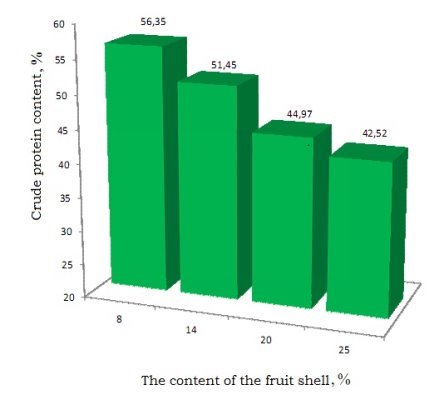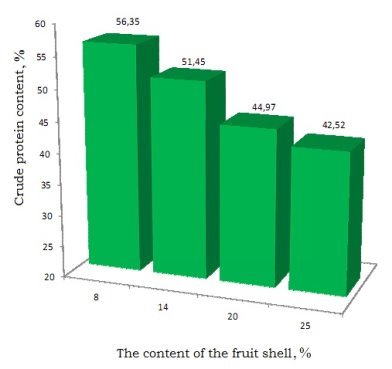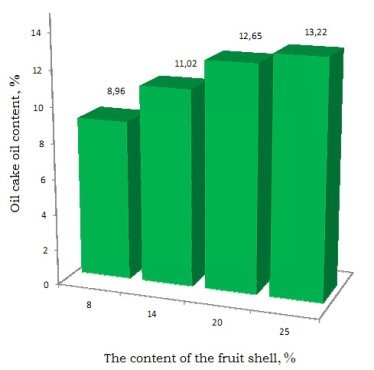The article studies the influence of the content of the fruit shell in the core fraction of melon seeds on the quality indicators and the yield of oil and cake during a single pressing on the press of the company “Farmet-20”. Model mixtures of the core fraction of melon seeds of the “Amiri” variety were used as the object of research. Model mixtures of the core fraction were prepared with a mass content of the fruit shell in the range from 8.0 % to 25.0 %.
Keywords: Fruit shell, sound fraction, melon seeds, Oil yield, Cake, Pressing, Model mixtures, Farmet-20, Melon oil, lipid.
Melon fruits are a valuable food and dietary product that is consumed fresh, dried. At canning enterprises of Uzbekistan, boiled mashed potatoes, juice, candied fruits, jam, marmalade, jam, bekmes (melon honey), etc. are produced from melon pulp. The waste in the production of the above products is seeds, which are currently practically not processed.
In the Republic of Uzbekistan, a lot of acreage occupied by melon crops is allocated for growing various varieties of melon. Melon seeds are a promising oilseed raw material containing from 33 % to 35 % of lipids and proteins from 35 % to 36 % on an absolutely dry substance. Therefore, the processing of melon seeds allows us to expand the range of vegetable oils belonging to the linoleic group, containing unsaturated fatty acids up to 85 %, which is very important for a healthy diet of the population of Uzbekistan, where animal fats predominate in consumption, as well as to obtain high-protein products. In this regard, an urgent task is to develop a technology for processing melon seeds to obtain delicious vegetable oil and high-protein cake. In our research, we studied the effect of the content of the fruit shell in the core fraction of melon seeds on the quality indicators and the yield of oil and cake during a single pressing on the Farmet-20 press.
Model mixtures of the core fraction of melon seeds of the «Amiri» variety were used as the object of research. Model mixtures of the core fraction were prepared with a mass content of the fruit shell in the range from 8.0 % to 25.0 %. Previously, melon seeds were calibrated on a sieve with a hole diameter of 5 mm. Next, the seed fraction of melon seeds was subjected to heat treatment by IR irradiation with bringing the temperature of the oilseed material to 90 O C and collapsed in a modernized centrifugal roller. Then, a model mixture of the core fraction of melon seeds with a given content of the fruit shell was prepared. Before pressing the oil, the core fraction was subjected to heating IR irradiation with bringing to a temperature from 68 O C to 70 O C and a constant humidity of all the studied samples of 6.0 ± 0.2 %. The influence of the fruit shell content in the core fraction on the oil output was studied at the previously established optimal adjustable parameters of the Farmet-20 press: the rotation speed of the press shaft is 40 revolutions per minute, the diameter of the outlet hole of the removable nozzle is 6 mm and the gap between the screw base and the pressing head is 3 mm. The results obtained are presented in Figures 1., 2. and 3. As can be seen from Figure 1, with a decrease in the content of the fruit shell in the core fraction of melon seeds from 25.0 % to 8.0 %, when oil is squeezed out of it, its yield increases from 25.4 % to 37.4 %. A similar pattern is observed in the processing of sunflower seeds [1]. A decrease in the content of the fruit shell in the core fractions also has a positive effect on the content of raw protein in the cake (Figure 2). As can be seen, the crude protein content with a fruit shell content of 8.0 % reaches up to 56.35 % for absolutely dry matter, which is significantly higher than the crude protein content in edible soy cake — at least 44 % for absolutely dry matter according to the requirements of GOST 8057–95. The decrease in the content of the fruit shell in the core fraction also significantly affects the residual oil content of the cake (Figure 3), which decreases to 8.96 % for absolutely dry matter with the content of the fruit shell of the core fraction of 8.0 %. For making operational decisions in process control and forecasting the specified quality of the products obtained, the following equations were obtained for calculating the yield of melon oil, crude protein and oil content of cake, depending on the content of the fruit shell in the core fraction of melon seeds processed on the Farmet-20 press:
V m = 49.1–0.66 L,
P r = 63.1 − 0.85 L,
M j = 7.2 + 0.25 L.
where V m is the oil yield, %; Pr is the crude protein content per absolutely dry substance in the resulting cake, %; M j is the residual oil content of the resulting cake per absolutely dry substance, %;
L — the content of the fruit shell in the core fraction, %

Fig. 1. The effect of the content of the fruit shell in the core fraction on the yield of melon oil

Fig. 2. The effect of the content of the fruit shell in the core fraction on the content of crude protein on the absolutely dry substance in the resulting cake.

Fig. 3. The effect of the content of the fruit shell in the core fraction on the residual oil content of the resulting cake on an absolutely dry substance
The discrepancies between the experimental and calculated data for equations (1, 2, 3) do not exceed ±4.8 %.
Table 1 shows the safety indicators of the cake obtained from the core fraction of melon seeds with a fruit shell content of 8.0 % and soy cake GOST 8057–95.
Table 1
Safety indicators of melon and soy cake
|
Name of the indicator |
Indicators of melon cake, mg/kg |
Food soy cake, mg/kg no more |
|
Lead |
0,35 |
0,5 |
|
Cadmium |
0,06 |
0,1 |
|
Mercury |
0,002 |
0,02 |
|
Arsenic |
0,056 |
0,2 |
|
Copper |
5,0 |
10,0 |
|
Nitrates |
0,05 |
450 |
As can be seen, the indicators of melon cake are not inferior in magnitude to the qualitative indicators of food soy cake, which confirms the high biological value of the resulting products, as well as the possibility of using it in the form of flour as food additives.
The effect of the content of the fruit shell in the core fraction of melon seeds during a single pressing on the Farmet-20 press on the quality indicators of the resulting oil is presented in Table 1.
First, we will consider the influence of the content of the fruit shell in the core fraction on the indicators of melon oil, which determine the degree of its oxidative damage, as the most important indicator of the quality of vegetable oils [2, 3, 4].
Results. The analysis of the results given in Table No. 1 indicates that there is a noticeable tendency to decrease the values of the studied indicators characterizing the quality of melon oil obtained from the core fraction of melon seeds, with a decrease in the content of the fruit shell of the samples.
Table 2
The effect of the content of the fruit shell in the core fraction on the main quality indicators of melon oil
|
The content of the fruit shell in the core fraction, % |
The main physical and chemical parameters of melons oil |
||||
|
Acid number, mg KOH/g |
Peroxide number, mmol of active oxygen /kg |
Phosphorus content, % in terms of stearooleolecitin citrine |
Mass fraction of unsaponifiable substances, % |
Color number mg of iodine |
|
|
8,0 |
0,91±0,02 |
2,26±0,03 |
0,034±0,005 |
0,256±0,01 |
8 |
|
14,0 |
0,94±0,01 |
2,41±0,02 |
0,061±0,002 |
0,261±0,02 |
|
|
20,0 |
0,96±0,02 |
2,54±0,03 |
0,093±0,002 |
0,267±0,02 |
|
|
25,0 |
1,01±0,04 |
2,89±0,03 |
0,102±0,006 |
0,274±0,01 |
|
As can be seen, with a decrease in the content of the fruit shell from 25.0 % to 8.0 % of the core fraction with a single pressing of the oil, its acid number decreases, respectively, from 1.01 mg KOH/g to 0.91 mg KOH/g. That is, the change in the acid number occurs by 9.9 %. More noticeably, with a decrease in the content of the fruit shell in the core fraction, the thermolabile oxidation products in the oil, characterized by a peroxide number, change, which decrease by 21 % from 2.89 mmol of active oxygen/kg to 2.26 mmol of active oxygen/kg. Obviously, such changes are associated to a greater extent with the qualitative parameters of the lipids of the fruit shell of melon seeds. However, in general, these indicators, which characterize oxidative spoilage, correspond to the high quality of the corresponding vegetable oil.
It should be noted the low content of phosphorus-containing substances in this oil, which ranges from 0.034 % to 0.102 % in terms of stearooleolecitin. At the same time, the share of a decrease in the content of phosphorus-containing substances with a decrease in the content of the fruit shell of samples of the core fraction of melon seeds is 66.7 %. In sunflower oil obtained from the pulp by single pressing, the proportion of changes in phosphorus-containing substances is 27.6 %, but with a decrease in the content of the fruit shell of the oilseed material, they increase from 0.21 % to 0.29 % in terms of stearooleolecitin [5]. Therefore, it is likely that the change in the content of phosphorus-containing substances in melon oil depends on their content in the lipids of the fruit shell of melon seeds.
A decrease in the content of the fruit shell in the core fraction of melon seeds leads to a slight decrease in the content of unsaponifiable substances in the resulting oil. For a change in their content is 6.6 %. A similar nature of the change in the content of unsaponifiable substances is observed in sunflower oil, depending on the change in the content of the fruit shell of the oilseed material. However, the value of the content of unsaponifiable substances in sunflower oil is from 2 to 4 times greater than in melon oil, and the proportion of changes in their content is 44 % when the content of the fruit shell of the samples changes to 5 % [5].
Thus, the content of substances that characterize the oxidative damage of melon oil, which are determined by the value of acid and peroxide numbers, depending on the change in the content of the fruit shell in the core fraction of melon seeds processed by a single pressing on the Farmet-20 press, generally change slightly. A decrease in the content of the fruit shell in the core fraction of melon seeds when extracting oil by single pressing also leads to a decrease in the content of phosphorus-containing and unsaponifiable substances in it. Therefore, the content of the above substances that determine the quality of the obtained melon oil is determined by their initial content in melon seeds. A similar nature of the change in the above indicators is observed during the processing of sunflower seeds with the preliminary separation of the fruit shell before extracting the oil [1, 6].
References:
- Lisitsyn A. N. Creation of technologies for pressing vegetable oils in conditions of high-intensity heating of an oil-containing material [Text]: abstract. diss... candidate of technical sciences. — St. Petersburg, 1996. — 33 p.
- Lisitsyn A. N. Development of the theoretical foundations of the process of oxidation of vegetable oils and the development of recommendations for improving their stability to oxidation [Text]: abstract of the Doctor of Technical Sciences. — Krasnodar, 2006. — 50 p.
- Lisitsyn A. N. The relationship between the capillary-porous structure, technological processes of oil extraction and oxidation [Text] / A. N. Lisitsyn, V. N. Grigorieva / / Fat-and-oil industry. — 2003. — No. 4. — pp. 16–22.
- Lisitsyn A. N. Theoretical and practical aspects of the oxidation of vegetable oils [Text] / A. N. Lisitsyn, V. N. Grigorieva, T. B. Alymova / / Fat-and-oil industry. — 2004. — No. 4. — pp. 10–14.
- The influence of kernel huskiness on the quality indicators of sunflower oil [Text] / Harutyunyan N. S., Kopeykovsky V. M., Arisheva E. A., Mkhitaryants L. A., Zozulya L. P. / / Fat and oil industry. — 1973. — No. 5-pp. 15–19.
- Savus A. S. Improving the technology of processing sunflower seeds with hard-to-break [Text]: abstract. diss... candidate of technical sciences. — Leningrad, 1990. — 28 p.
- Site materials http://www farmet.ru
- Site materials http://www fitoproduct.uz/oil.php?id=melon
- Site Materials http://ru.wikipedia.org.wiki
- Site Materials http://www ovoschevodstvo.com







